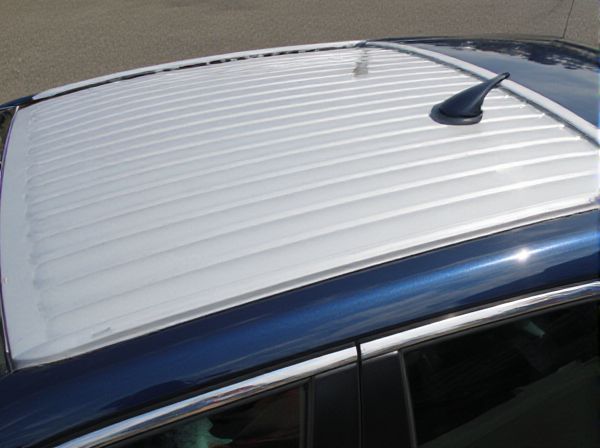
Photo illustration: Louvered Roof vs Solid Roof
A louvered roof offers adjustable slats that provide dynamic control over sunlight and ventilation, enhancing outdoor comfort. In contrast, a solid roof delivers consistent protection from rain and UV rays, making it ideal for permanent shelter needs. Your choice depends on whether flexibility or fixed coverage is the priority for your outdoor space.
Table of Comparison
| Feature | Louvered Roof | Solid Roof |
|---|---|---|
| Material | Aluminum or composite slats | Metal, fiberglass, or hard plastic |
| Ventilation | Adjustable slats for airflow control | No ventilation, fully enclosed |
| Weather Protection | Water-resistant when closed, partial protection | Complete protection from rain and snow |
| Light Control | Variable natural light via adjustable louvers | Blocks natural light completely |
| Weight | Lighter due to slatted design | Heavier and rigid structure |
| Installation | More complex with moving parts | Simpler, fixed installation |
| Maintenance | Requires regular cleaning and adjustment | Low maintenance |
| Cost | Higher initial cost | Generally lower cost |
Introduction to Louvered Roofs and Solid Roofs
Louvered roofs consist of adjustable slats that control sunlight and ventilation, offering flexibility for outdoor spaces. Solid roofs provide fixed, durable shelter with consistent protection against weather elements like rain and UV rays. Choosing between louvered and solid roofs depends on the desired balance of airflow, light control, and weather resistance for patios or pergolas.
Key Differences Between Louvered and Solid Roofs
Louvered roofs feature adjustable slats that provide customizable ventilation and natural light control, while solid roofs offer fixed, permanent coverage for maximum protection against weather elements. Louvered roofs enhance airflow and adaptability, making them ideal for outdoor living spaces, whereas solid roofs ensure superior insulation and consistent shelter from rain and sun. The choice between louvered and solid roofs depends on the desired balance between flexibility, climate control, and durability.
Design and Aesthetic Considerations
Louvered roofs offer a modern, dynamic design with adjustable slats that control light and ventilation, creating a versatile outdoor space that adapts to changing weather. Solid roofs provide a more traditional, permanent aesthetic with a consistent, sheltered environment ideal for year-round use but limit natural light and airflow. Both designs can be customized with various materials and finishes to complement architectural styles, but louvered roofs emphasize flexibility and contemporary appeal while solid roofs prioritize durability and classic shelter.
Weather Protection and Durability
Louvered roofs offer adjustable slats that provide flexible weather protection by allowing ventilation and controlling sunlight, while solid roofs deliver consistent shelter against rain, snow, and wind due to their fixed, impermeable structure. Durable materials like aluminum and powder-coated steel enhance the longevity of louvered roofs, resisting rust and wear, whereas solid roofs often use robust materials such as polycarbonate or metal sheets known for withstanding harsh weather conditions over time. When prioritizing weather protection and durability, solid roofs excel in complete coverage and structural integrity, whereas louvered roofs balance protection with adaptable ventilation for variable climates.
Light and Ventilation Control
Louvered roofs offer adjustable slats that control natural light and airflow, allowing precise ventilation and shading based on weather conditions. Solid roofs provide consistent protection from rain and sun but limit ventilation and natural light adjustments. For flexible outdoor comfort, louvered roofs excel in managing light intensity and air circulation compared to fixed solid roofing.
Installation Process and Complexity
Installing a louvered roof involves integrating adjustable aluminum or metal slats with a motorized or manual control system, requiring precise alignment and electrical work for optimal functionality. In contrast, a solid roof installation is generally more straightforward, involving placing fixed panels such as metal, polycarbonate, or shingles on a stable frame without moving parts, simplifying the structural and labor requirements. The complexity of a louvered roof installation demands specialized skills and typically longer installation times compared to the relatively quicker and less intricate process of solid roof construction.
Cost Comparison and Long-Term Value
A louvered roof typically costs between $5,000 and $15,000 depending on size and materials, offering adjustable shading and ventilation for enhanced comfort and energy savings. Solid roofs range from $7,000 to $20,000, providing consistent weather protection but lacking airflow control. Over time, louvered roofs deliver better long-term value through energy efficiency and increased outdoor usability, while solid roofs may require less maintenance but offer less flexibility in climate management.
Maintenance Requirements
Louvered roofs require regular cleaning to prevent debris buildup between the adjustable slats and occasional lubrication to ensure smooth operation. Solid roofs demand less frequent maintenance but need routine inspections for leaks, especially after heavy rainfall, and periodic cleaning to avoid mold or dirt accumulation. Both systems benefit from professional servicing to maintain durability and optimal performance over time.
Ideal Use Cases and Applications
Louvered roofs provide adjustable shading and ventilation, making them ideal for outdoor patios, restaurants, and pool areas where flexibility in sun and airflow control is essential. Solid roofs offer permanent protection from weather elements, best suited for spaces requiring consistent shelter such as sunrooms, garages, and covered walkways. Homeowners and businesses often choose louvered roofs for dynamic environments and solid roofs for robust, all-weather coverage.
Which Roof Option is Best for Your Needs?
Choosing between a louvered roof and a solid roof depends on your climate, lifestyle, and desired outdoor experience. A louvered roof offers adjustable shading and ventilation, ideal for regions with variable weather and those seeking control over sunlight and airflow. A solid roof provides consistent protection from rain and extreme sun, making it suitable for areas with harsh weather conditions or for creating fully sheltered outdoor spaces.
 caratoz.com
caratoz.com